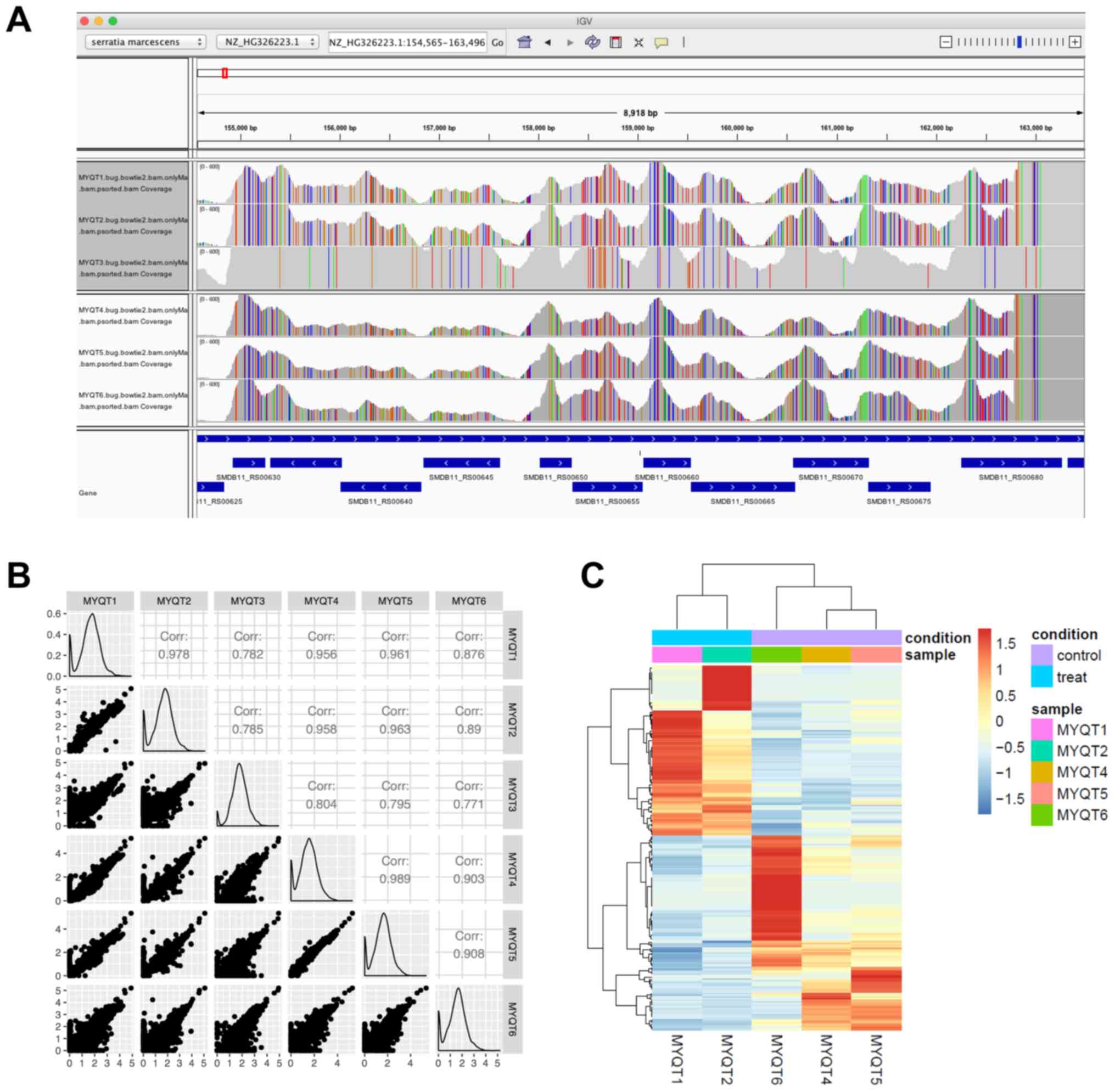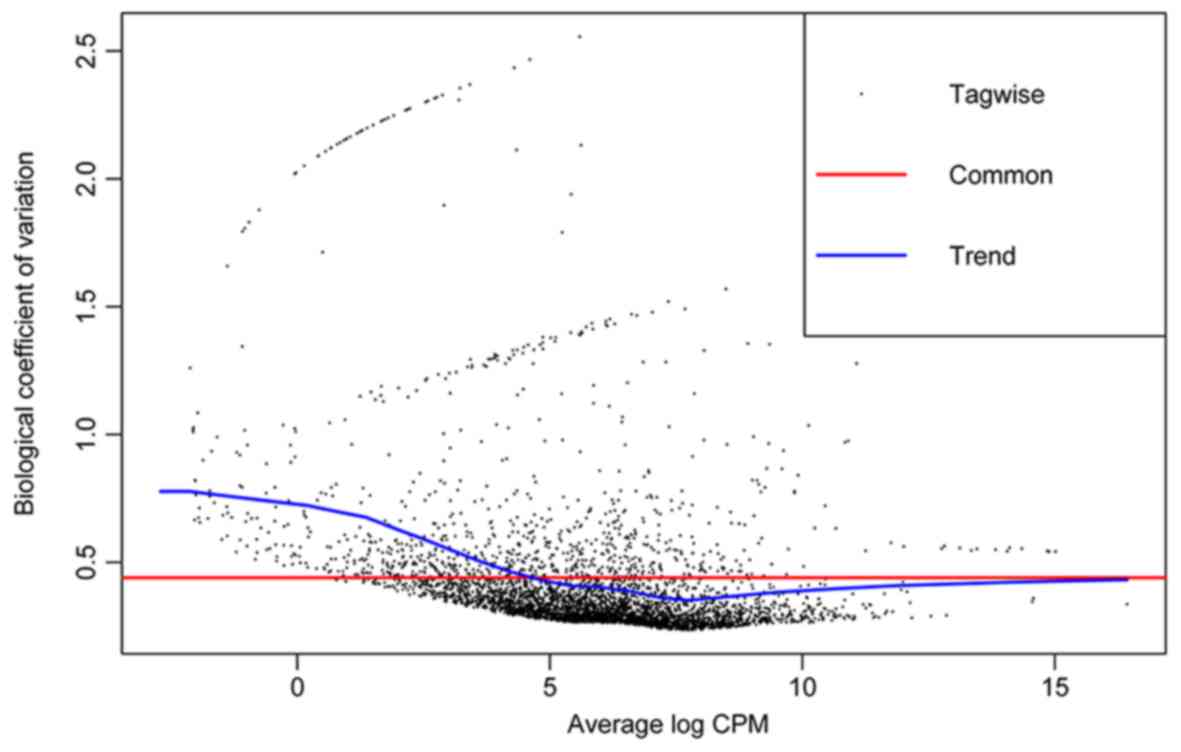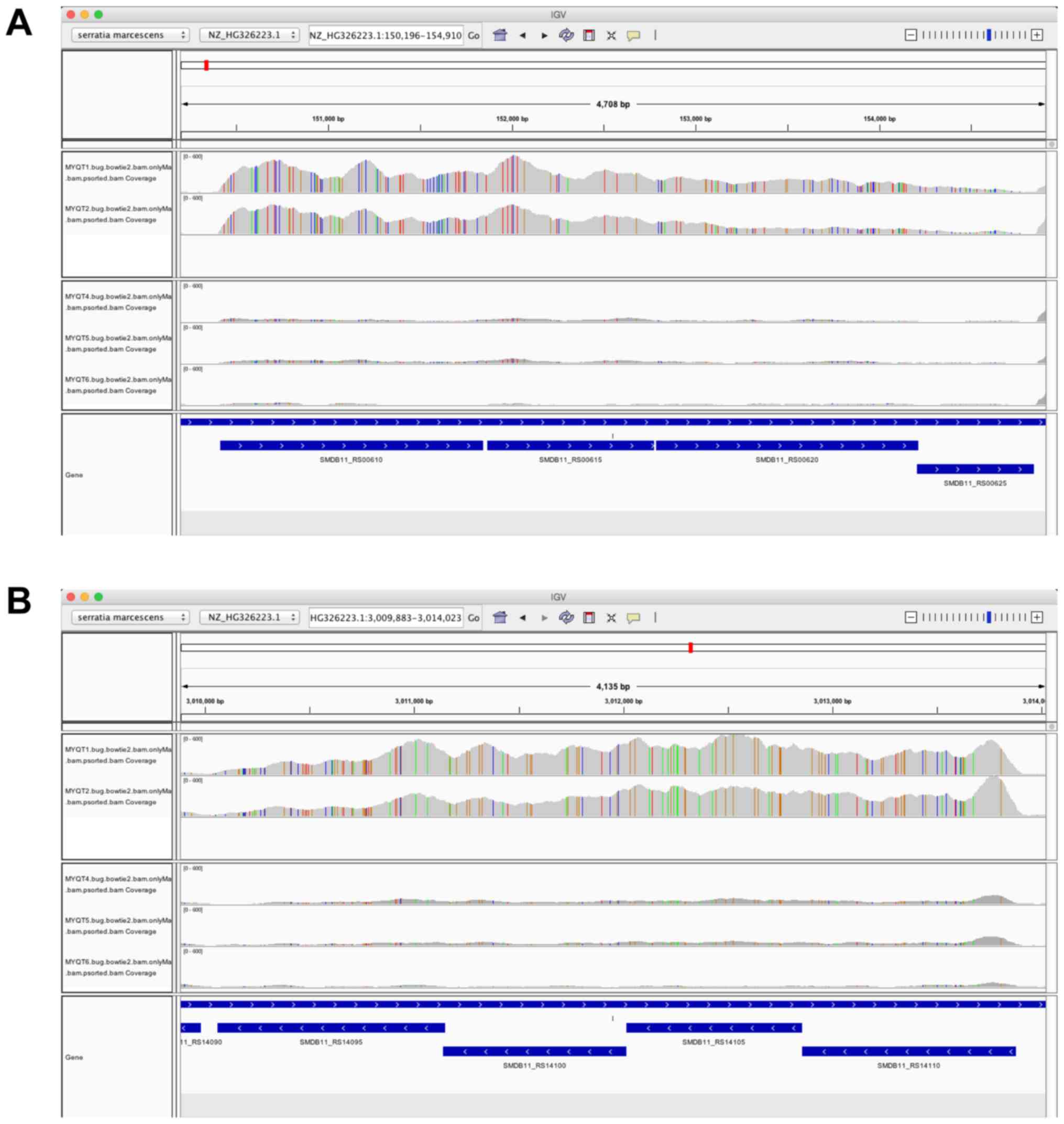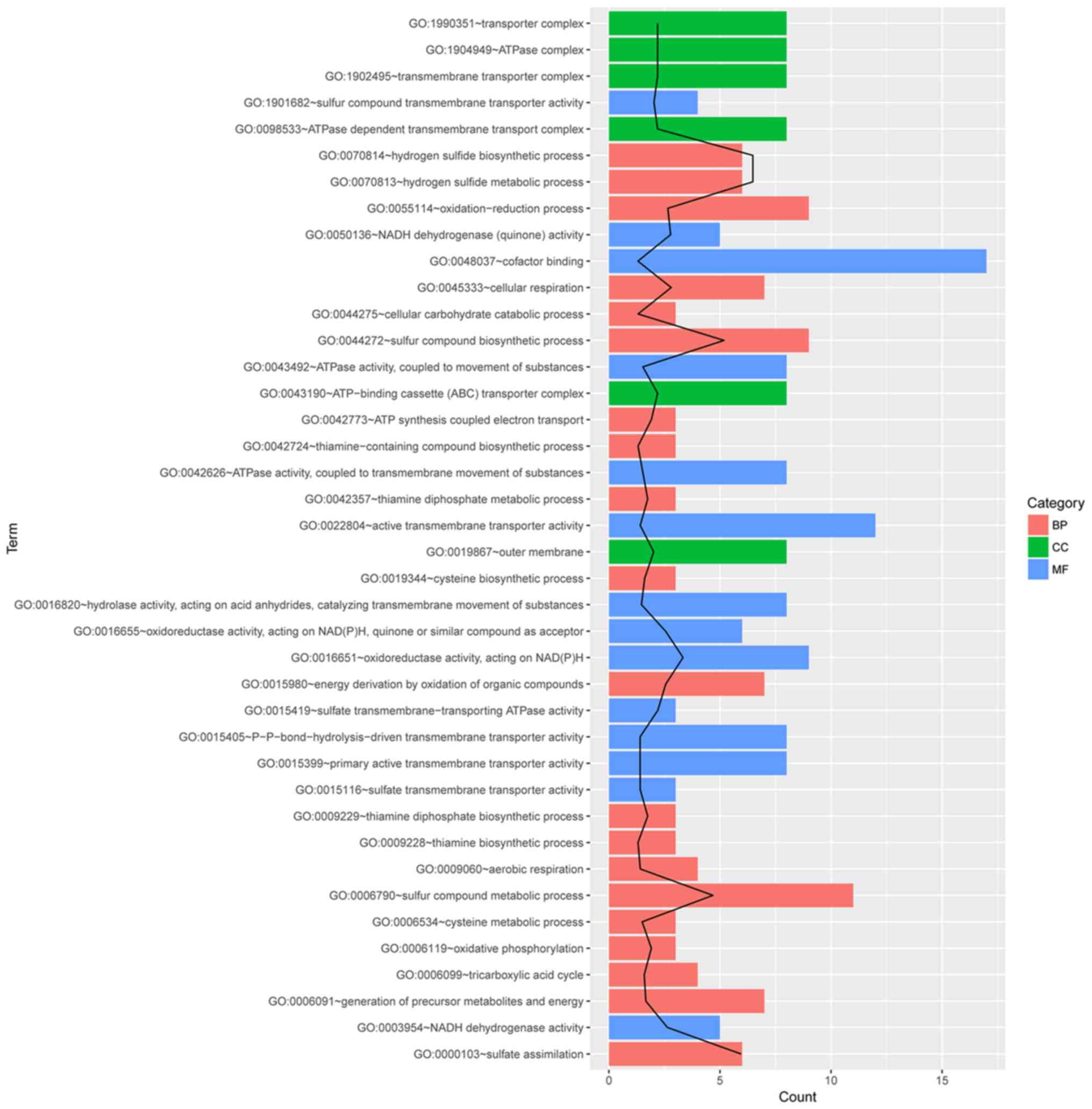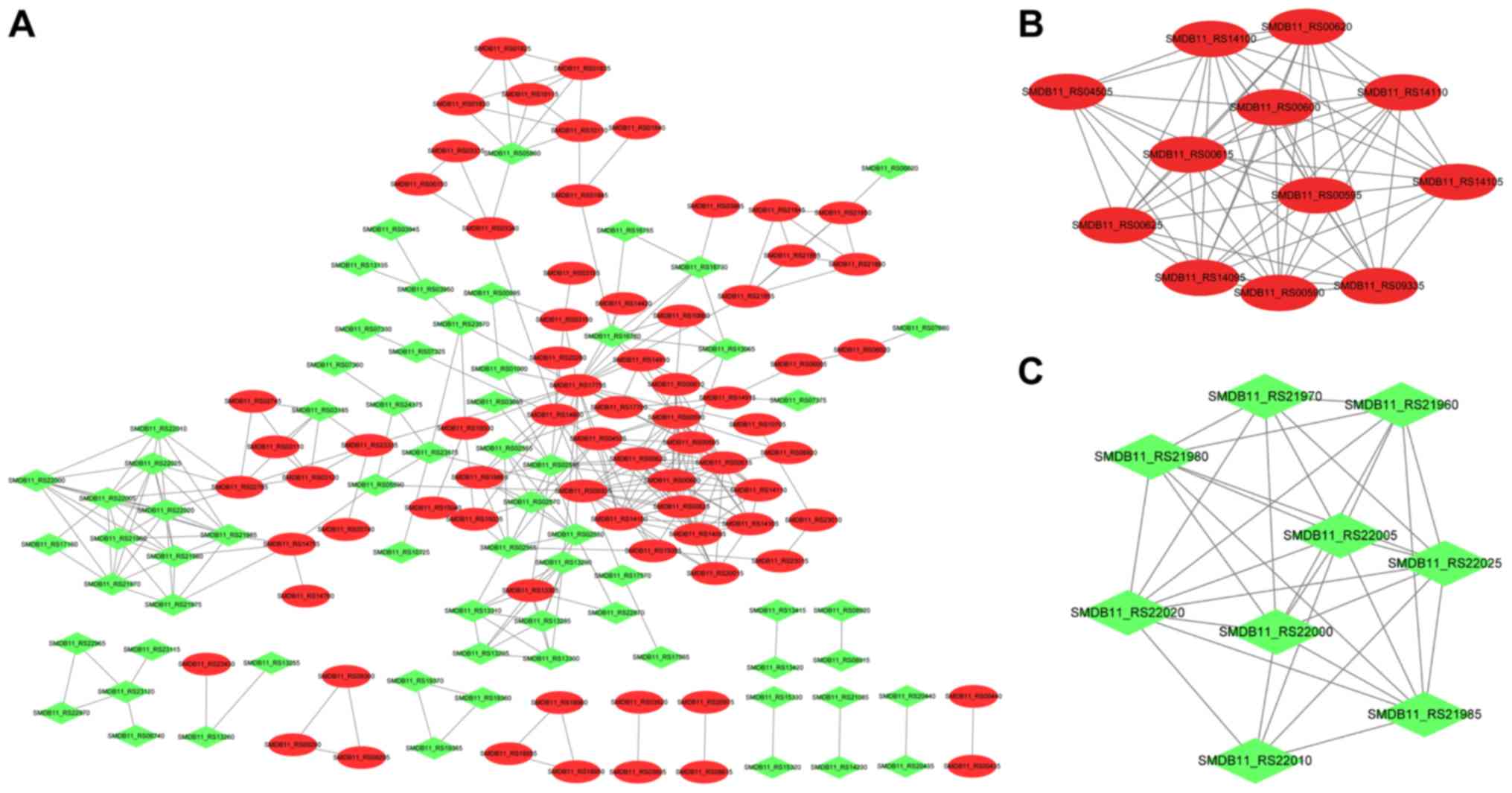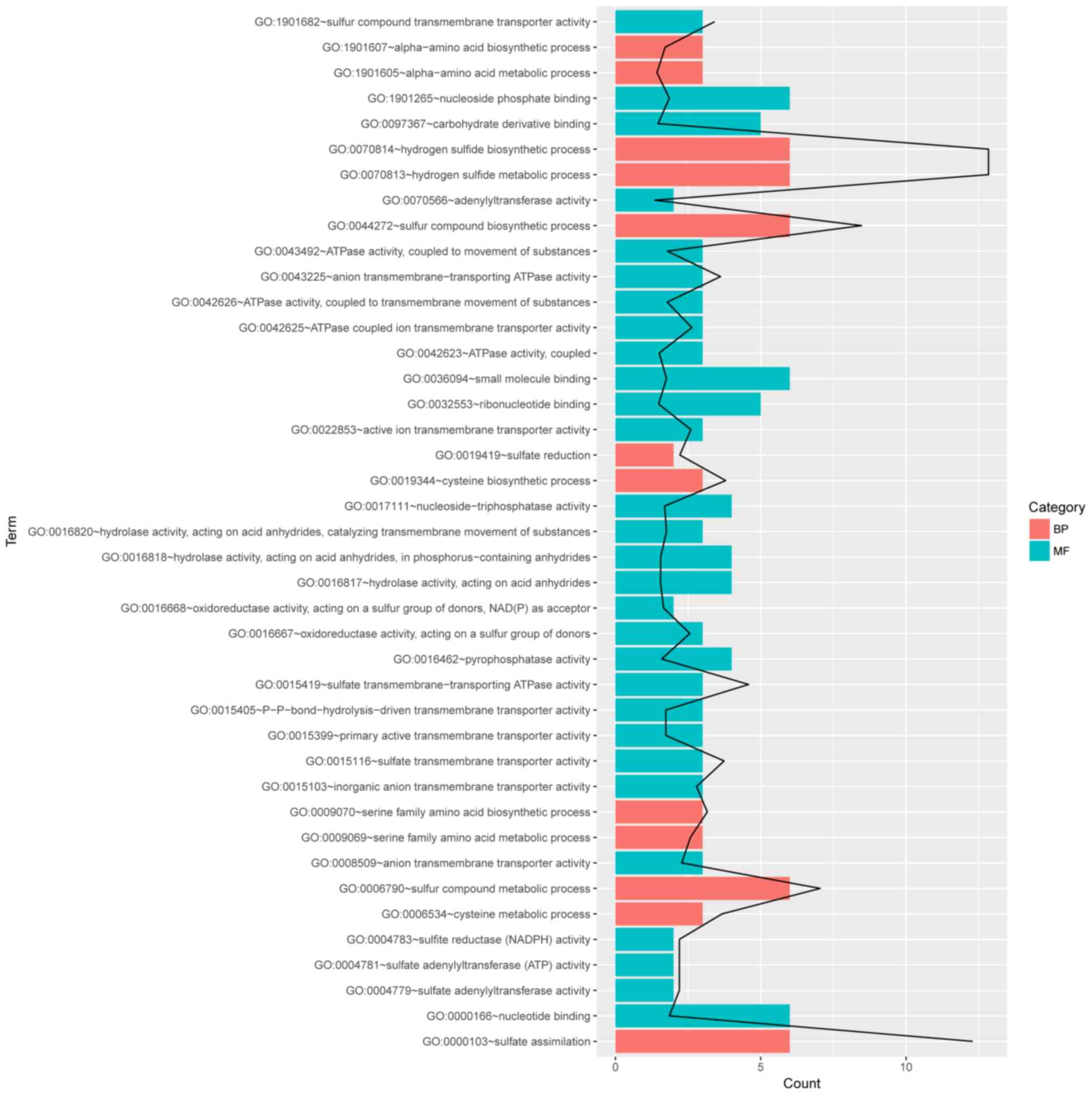RNA‑seq analyses of antibiotic resistance mechanisms in Serratia marcescens
- Authors:
- Published online on: May 22, 2019 https://doi.org/10.3892/mmr.2019.10281
- Pages: 745-754
-
Copyright: © Li et al. This is an open access article distributed under the terms of Creative Commons Attribution License.
Abstract
Introduction
Multidrug-resistant bacterial infections, especially those caused by Gram-negative pathogens, have become a significant global public health threat, and they result in considerable patient mortality and morbidity and cause great economic and production losses in the community (1). Serratia marcescens (S. marcescens), a Gram-negative bacillus, is an important nosocomial pathogen that can cause an array of infections, such as bloodstream infections, pneumonia, urinary tract infections, central nervous system infections, and conjunctivitis (2). The development of novel antibiotics, especially those used to treat multidrug-resistant pathogens, has stagnated over the last half century. Therefore, gaining more insights into the genetic mechanisms responsible for the antimicrobial resistance of pathogens is both urgent and necessary.
The accumulation of evidence has led to the identification of a number of genes that are responsible for intrinsic resistance to different classes of antibiotics, including β-lactams, aminoglycosides, and fluoroquinolones (3). Intrinsic mechanisms underlying bacterial antibiotic resistance include naturally occurring genes found in the chromosome of the host, such as the multiple multidrug-resistant efflux systems of β-lactamase of Gram-negative bacteria (4). A recent study reported an isolate of S. marcescens harboring the 16S rRNA methyltransferase gene rmtB, together with various β-lactamase genes and quinolone resistance genes (5). Another study revealed that imipenem-resistance in S. marcescens may be mediated by the plasmid expression of Klebsiella pneumoniae carbapenemase-2 (KPC-2) (6). In addition, evidence has demonstrated that Gram-negative bacteria can employ several strategies to protect themselves from polymyxin antibiotics, including a variety of lipopolysaccharide (LPS) modifications in addition to the formation of capsules, use of efflux pumps, and overexpression of the outer membrane protein OprH (7). Although many studies aimed at elucidating the underlying mechanisms of antibiotic resistance have been performed, much remains largely unknown, especially the molecular mechanisms of the multi-drug resistance of S. marcescens, and awaits discovery.
The development of next-generation sequencing technologies has provided valuable resources for genetic research and other scientific disciplines (8,9). In this study, the parental S. marcescens strain and S. marcescens strains exhibiting multidrug-resistance were analyzed with high-throughput RNA sequencing to identify variations at the transcriptome level. Differentially expressed genes (DEGs) between the parental strain and the multidrug-resistant S. marcescens strains were screened, followed by functional enrichment analysis, protein-protein interaction (PPI) network construction, and module extraction. The results provide additional molecular clues that will aid in elucidating the mechanisms and metabolic pathways related to multidrug-resistance in S. marcescens.
Materials and methods
Bacterial strains and culture conditions
Bacterial isolation, identification, and culture were performed according to conventional methods. The strains were derived from sputum, blood, lavage fluid, urine, and throat swab samples; transferred onto Columbia agar supplemented with 5% sheep blood (bioMérieux, Marcy l'Etoile, France) and MacConkey's agar plates; and incubated at 35°C for 24 h. The oxidase-negative Gram-negative bacilli was identified using the VITEK® 2 GN card (bioMérieux) (10). The drug sensitivity AST-GN16 card was used to test the antimicrobial agent susceptibility of the isolated strains. In this study, a total of three drug-susceptible S. marcescens strains (named MYQT1, MYQT2, and MYQT3) and three multidrug-resistant S. marcescens strains (named MYQT4, MYQT5, and MYQT6) were obtained from six different patients and used for the follow-up analysis.
Total RNA extraction
The cultures were centrifuged at 8,000 × g to precipitate bacterial cells. Total RNA was extracted using the hot phenol method as previously described with modifications (11). Subsequently, the bacterial cells were washed two times with RNAse-free saline or phosphate-buffered saline (PBS; cat. no. E607016-0500; BBI solutions, Cardiff, UK). Then, 400–600 µl TES solution was added according to the precipitation amount, and the bacterial cells were resuspended. The same amount of phenol-water (Sinopharm Chemical Reagent Co., Ltd., Shanghai, China) was added followed by violent mixing. Centrifuge tubes containing a mixture of each sample, TES, and phenol-water were agitated at 65°C for 30–60 min in a Thermomixer Compact 5350 (Eppendorf, Hamburg, Germany), and then, the tubes were placed on ice and allowed to stand for 5 min. Then, the mixtures were centrifuged at 11,000 × g for 10 min at 4°C. The upper aqueous phase was selected and transferred to a new tube. Subsequently, a 1/2 volume of TRK-1002 lysis-solution and 2/3 volume of 95% ethyl alcohol was added to the upper aqueous phase, followed by vortex blending. Total RNA was then extracted using a TRK-1002 Purification kit (LC Sciences, Houston TX, USA), following the manufacturer's instructions. RNA quality was evaluated using an Agilent Bioanalyser (Agilent Technologies, Inc., Santa Clara, CA, USA).
Library preparation and Illumina sequencing
To remove ribosomal RNA, we used a Ribo-Zero™ Magnetic kit (Bacteria) (cat. no. MRZB12424; Illumina, Inc., San Diego, CA, USA) according to the manufacturer's protocol. RNA samples were subjected to further purification using a Zymo RNA Clean and Concentrator kit (cat. no. R1015; Zymo Research, Irvine, CA, USA) to enrich the mRNA according to the manufacturer's instructions. Each mRNA sample was suspended in 10 µl of RNase-free water, and the concentration of the obtained RNA was determined. Bacterial mRNA was fragmented and stranded, and paired-end libraries of total RNA were generated using Illumina TruSeq Stranded Total RNA HT Sample Preparation kits (cat. no. RS-122-2203, Illumina, Inc.). All the samples were sequenced using an Illumina HiSeq X10 sequencer (Illumina, Inc.).
Mapping of reads and differential expression analysis
RNA-seq datasets were obtained from six samples from two experiment settings. The original RNA-seq datasets were MYQT1, MYQT2, MYQT3, MYQT4, MYQT5, and MYQT6 with 9748744, 9669644, 9765080, 9638041, 9742165, and 9750956 read pairs. All RNA-seq reads were cleaned with Trimmomatic (12), and then, the read qualities were ascertained with FastQC (https://www.bioinformatics.babraham.ac.uk/projects/fastqc/). In order to determine the appropriate reference genome to use for read mapping, all cleaned RNA-seq reads we first used to perform BLAST (ftp://ftp.ncbi.nlm.nih.gov/blast/executables/blast+/LATEST/) searches against the NCBI nt database. The BLAST results indicated that S. marcescens subsp. marcescens Db11 was the closest reference genome. The six cleaned RNA-seq datasets to S. marcescens subsp. marcescens Db11 were then mapped using Bowtie 2 (13). In addition, the genomic viewer Integrative Genomics Viewer (IGV) (14) was used to evaluate the mapping quality. BEDtools (15) was used to calculate the read count of each gene over the six samples. Correlation analysis was performed to ensure that the read count qualities were stable within samples (across three different batches).
edgeR (16) uses the calcNormFactors function to normalize for RNA composition by finding a set of scaling factors for the library sizes that minimize the log-fold changes (FC) between the samples for most genes (16). In this study, edgeR (16) was used to perform differential gene expression analysis. edgeR uses the Cox-Reid profile-adjusted likelihood (CR) method for estimating dispersions (16). The screening criteria were |log2FC|>1 and a P-value <0.05. Additionally, IGV was used to zoom in on some significant DEGs.
Functional enrichment of DEGs
The functional enrichment tool DAVID (17) was applied to perform enrichment analysis. In the analysis, functional annotations of gene ontology (GO), including the ontology of cellular component (CC), biological process (BP), and molecular function (MF) were mostly focused on (18). The GO terms with a gene count >2 and a P-value <0.05 were considered statistically significant.
PPI construction and analysis
The STRING database (19) contains known and predicted protein-protein associations that are integrated and transferred across organisms. Since S. marcescens in this study was not included in the STRING database, the Serratia odorifera 4Rx13 strain was used in the database which has a high degree of homology with S. marcescens. The protein sequences of the DEGs were downloaded from the NCBI database and blasted in the STRING database, and the interactions between the proteins were predicted. Required Confidence (combined score) >0.4 was selected as the threshold for predicting PPIs.
Cytoscape 3.4.0 (https://cytoscape.org/) is an open source software project for biological network visualization and data integration. According to the network connectivity, important nodes in the PPI network could be identified (20). In the present study, three calculation methods for determining network topology properties were combined, including degree centrality (21), betweenness centrality (22), and closeness centrality (23), and the importance of nodes was analyzed in the network. The Cytoscape plugin CytoNCA (24) was used for the calculation of network topology properties (parameter setting: Network, without weight). In CytoNCA output, the higher the node score is, the more important the position in the network, and the more likely it is to be the key node.
Module selection and analysis
In PPI networks, similar functional proteins tend to cluster together and co-occur in central network locations (25). Therefore, studying the protein complex of a PPI network or functional clustering module can help determine the unknown functions of proteins. In the present study, the MCODE (26) tool was applied to extract significant modules from the PPI network. The default parameters were set as Degree Cutoff: 2; Node Score Cutoff: 0.2; K-Core: 2; and Max. Depth: 100. Moreover, GO enrichment analysis was performed for genes in the selected modules with a threshold of a gene count >2 and a P-value <0.05.
Results
RNA-seq analysis of the bacterial samples
After read cleaning, there were 8088448, 7929058, 8070351, 8229630, 8240862, and 8193913 read pairs in MYQT1, MYQT2, MYQT3, MYQT4, MYQT5, and MYQT6, respectively. The overall alignment rates to the closest reference genome were 72, 81, 93, 77, 82, and 82% for MYQT1, MYQT2, MYQT3, MYQT4, MYQT5, and MYQT6, respectively. In the IGV screenshot (Fig. 1A), we present the locus tags from SMDB11_RS00620 to SMDB11_RS00680. This genomic region was selected picked since most of the samples had a high read coverage. In the IGV plot, the vertical strips (in red, green, blue, or orange) indicate where the RNA-seq reads contained different nucleotides (mutated nucleotides/SNPs). The five samples excluding MYQT3 had similar SNP patterns, leading us to question whether the MYQT3 data corresponded to a different S. marcescens strain. As presented in Fig. 1B, each small scatter plot reveals the correlation of gene expression [presented and normalized transcripts per million (TPM)] between two samples. As revealed in the plot, MYQT3 had very a different expression pattern compared to MYQT1 and MYQT2, and thus, MYQT3 was excluded from the following analysis.
Differential expression analysis
edgeR calculates the quadratic mean-variance (dispersion) relationship to moderate the degree of dispersion across features (genes) (Fig. 2). With the threshold of |log2 FC|>1 and a P-value <0.05, a total of 225 DEGs were identified. The most significant DEG was SMDB11_RS09300 (GTP cyclohydrolase FolE2) with a log2 FC of 6.4. The heat map is presented in Fig. 1C.
Using IGV, we identified the genomic region where the most significant DE gene was located, which was the region from locus tag SMDB11_RS00610 to SMDB11_RS00625 (siroheme synthase, sulfate adenylyltransferase subunit 2, sulfate adenylyltransferase, and adenylyl-sulfate kinase) (Fig. 3A). The four genes were all identified as DEGs by edgeR, and the four genes were highly expressed in the MYQT1 and MYQT2 groups compared to that in the other groups (MYQT4, MYQT5, and MYQT6). The IGV plot of this region strongly supported the conclusion that the four genes belonged to the same operon. Additionally, the genomic region from locus tag SMDB11_RS14095 to SMDB11_RS14110 (sulfate/thiosulfate transporter subunit, sulfate/thiosulfate transporter permease subunit, sulfate/thiosulfate transporter subunit, and thiosulfate transporter subunit) (Fig. 3B) was also assessed. The four genes were all identified as DEGs by edgeR, and the four genes were highly expressed in the MYQT1 and MYQT2 groups compared to that in the other groups (MYQT4, MYQT5, and MYQT6). Once again, the IGV plot of this region strongly supported the conclusion that the four genes belonged to the same operon.
Functional enrichment analysis of DEGs
The 225 DEGs were used to perform functional enrichment analysis, and several GO terms related to antibiotic-resistant mechanisms were identified. The initial assessment of the two sets of significant DE genes and their gene names (in the two IGV plots) indicated that hydrogen sulfide metabolic process and sulfate transmembrane-transporting ATPase activity may be enriched. Specifically, as revealed in Fig. 4, the first two enriched functional groups were GO:0070814~hydrogen sulfide biosynthetic process and GO:1901682~sulfur compound transmembrane transporter activity. The first two GO terms mostly reflected the two sets of DEGs (operons) we identified in the DEG analysis. The other GO term related to antibiotics-resistant mechanisms was GO:0043190~ATP-binding cassette (ABC) transporter complex.
Construction and analysis of the PPI network and extraction of significant modules
The PPI network was constructed (Fig. 5A) and consisted of 140 nodes (proteins) and 318 edges (interactions). After analyzing three types of network topology properties of nodes in the PPI network, 15 important nodes were identified, as revealed in Table I. The results indicated that four DEGs (SMDB11_RS17755, SMDB11_RS00590, SMDB11_RS04505, and SMDB11_RS02545) belonged to the top 15 genes regardless of the calculation method used.
With the use of the MCODE plug-in, the two modules with the highest score were obtained (Fig. 5B and C). As revealed in Fig. 5B, cluster 1 (score=11.27) had 12 nodes and 62 interactions. Cluster 2 (score=8), as revealed in Fig. 4C, consisted of 9 nodes and 32 interactions. In special, SMDB11_RS00590 and SMDB11_RS04505 belonged to cluster 1. Moreover, enrichment analysis of the genes in the enriched clusters (Fig. 6) was performed. No GO terms were identified for genes in cluster 2, and there were 41 GO terms enriched for cluster 1, such as hydrogen sulfide metabolic process, sulfate assimilation, and sulfur compound biosynthetic process.
Discussion
Understanding the genetic mechanisms that underlie the antibiotic resistance of bacteria is a critical issue. In this study, we used RNA-seq to investigate the patterns of gene expression that may be associated with the antibiotic resistance mechanisms of S. marcescens. A total of 225 DEGs were identified, of which upregulated SMDB11_RS09300 (GTP cyclohydrolase FolE2) was the most significant with a log2 FC of 6.4, and these DEGs were enriched in different GO terms, including hydrogen sulfide biosynthetic process, sulfur compound transmembrane transporter activity, and ABC transporter complex. Additionally, several genes were identified to be important genes in the PPI network, including SMDB11_RS17755 (upregulated; glutamate synthase large subunit), SMDB11_RS00590 (upregulated; sulfite reductase subunit A), and SMDB11_RS04505 (upregulated; cystathionine β-synthase). Functional enrichment analysis of genes in significant clusters revealed that genes were associated with sulfur metabolism.
SMDB11_RS09300 encodes GTP cyclohydrolase FolE2 (27), an enzyme involved in the biosynthesis of folic acid and pteridines (28,29). There is evidence that the folic acid biosynthesis pathway may be a potential target for the development of antibiotics, and this has been validated by the clinical use of several drugs (30). Rengarajan et al demonstrated that folate metabolism was a target for resistance to a type of antibiotic (31). In the present study, upregulated SMDB11_RS09300 was revealed to have the highest expression change in the multidrug-resistant S. marcescens, which was consistent with previous studies indicating that the upregulation of SMDB11_RS09300 may play a significant role in the multidrug-resistant mechanisms of S. marcescens by participating in folate metabolism.
Glutamate synthase is important as it provides glutamate for glutamine synthetase reaction (32). A study showed that the export of glutamine synthetase was associated with the formation of the poly-L-glutamate/glutamine cell wall structure of organisms (33). A decrease in extracellular glutamine synthetase activity can inhibit bacterial growth (34). Evidence has indicated that several cell-wall-related genes can be strongly expressed in Staphylococcus aureus in response to antibiotics, such as gltD, which encodes the small subunit of glutamate synthase (35). In the present study, it was revealed that SMDB11_RS17755 (glutamate synthase large subunit) was upregulated and was a hub protein in the PPI network, suggesting that the upregulation of this gene may contribute to cell wall metabolism, which may defend S. marcescens against the antibacterial activities of the agents.
Moreover, SMDB11_RS00590 (sulfite reductase subunit α) and SMDB11_RS04505 (cystathionine β-synthase) were also upregulated and played important roles in the PPI network in this study. The sulfite reductases catalyze the reduction of sulfite to sulfide (36), and cystathionine β-synthase is also a sulfur metabolism enzyme (37). Synthetic antimicrobial agents such as the ‘sulfa drugs’ (sulfonamides) have also been brought into wider usage, and they can inhibit steps in folic acid metabolism (38). Sulfur metabolic pathways are essential for survival and virulence of many pathogenic bacteria and represent a promising new area for therapy against multidrug resistant microbes (39). In the present study, the identified 225 DEGs and genes in the significant cluster 1 were mainly associated with sulfur metabolism. Thus, it was concluded that the upregulation of SMDB11_RS00590 and SMDB11_RS04505, which were involved in the sulfur metabolism in S. Marcescens, may be critical in its antibiotic resistance mechanisms. However, further studies are required to validate the roles of these genes.
However, the major limitation of this study was that a small number of replicates was used, which did not provide sufficient statistical power to assess the significance of the findings. Thus, the results of this study require confirmation in the future, i.e., when more replicates and confirmatory experiments using additional techniques (e.g., qPCR) are available. Another limitation of this study was that the associations used to construct the PPI network were derived from another species due to the lack of S. marcescens in the database. Thus, more studies are required to verify the biological interpretation of these results.
In conclusion, this study profiled genes in multidrug-resistant S. marcescens using RNA sequencing. SMDB11_RS09300 may play a significant role in the multidrug-resistant mechanisms of S. marcescens by participating in folate metabolism. SMDB11_RS17755 may contribute to the integrity of cell membranes, which is involved in the multi-drug resistance of S. marcescens. The upregulation of SMDB11_RS00590 and SMDB11_RS04505 in S. marcescens may be critical in its antibiotic resistance mechanisms. Further studies with a large panel of isolates are required to validate these findings. However, these findings are important and will aid in better understanding bacterial resistance to these drugs.
Acknowledgements
Not applicable.
Funding
The present study was supported by The Medical and Health Science and Technology Plan of Zhejiang Province (Program no. 2019KY134) and The Hangzhou Health and Family Planning Technology Plan (Program no. 2018Z07).
Availability of data and materials
The datasets used and/or analyzed during the current study are available from the corresponding author on reasonable request.
Authors' contributions
ZL and MD conceived the present study. ZL drafted the manuscript. MX and HW collected and analyzed the data. LW interpreted the data. All authors read and approved the final manuscript, and agreed to be accountable for all aspects of the work in ensuring that questions related to the accuracy or integrity of any part of the work are appropriately investigated and resolved.
Ethics approval and consent to participate
Not applicable.
Patient consent for publication
Not applicable.
Competing interests
The authors declare that they have no competing interests.
Glossary
Abbreviations
Abbreviations:
|
KPC-2 |
Klebsiella pneumoniae carbapenemase-2 |
|
LPS |
lipopolysaccharide |
|
DEGs |
differentially expressed genes |
|
PPI |
protein-protein interaction |
References
|
Courtney CM, Goodman SM, McDaniel JA, Madinger NE, Chatterjee A and Nagpal P: Photoexcited quantum dots for killing multidrug-resistant bacteria. Nat Mater. 15:529–534. 2016. View Article : Google Scholar : PubMed/NCBI | |
|
Iguchi A, Nagaya Y, Pradel E, Ooka T, Ogura Y, Katsura K, Kurokawa K, Oshima K, Hattori M, Parkhill J, et al: Genome evolution and plasticity of Serratia marcescens, an important multidrug-resistant nosocomial pathogen. Genome Biol Evol. 6:2096–2110. 2014. View Article : Google Scholar : PubMed/NCBI | |
|
Blair JM, Webber MA, Baylay AJ, Ogbolu DO and Piddock LJ: Molecular mechanisms of antibiotic resistance. Nat Rev Microbiol. 13:42–51. 2015. View Article : Google Scholar : PubMed/NCBI | |
|
Alekshun MN and Levy SB: Molecular mechanisms of antibacterial multidrug resistance. Cell. 128:1037–1050. 2007. View Article : Google Scholar : PubMed/NCBI | |
|
Ma XJ, Yang HF, Liu YY, Mei Q, Ye Y, Li HR, Cheng J and Li JB: The emergence of the 16S rRNA methyltransferase RmtB in a multidrug-resistant Serratia marcescens isolate in China. Ann Lab Med. 35:172–174. 2015. View Article : Google Scholar : PubMed/NCBI | |
|
Su W, Zhu Y, Deng N and Li L: Imipenem-resistance in Serratia marcescens is mediated by plasmid expression of KPC-2. Eur Rev Med Pharmacol Sci. 21:1690–1694. 2017.PubMed/NCBI | |
|
Olaitan AO, Morand S and Rolain JM: Mechanisms of polymyxin resistance: Acquired and intrinsic resistance in bacteria. Front Microbiol. 5:6432014. View Article : Google Scholar : PubMed/NCBI | |
|
Rabbani B, Nakaoka H, Akhondzadeh S, Tekin M and Mahdieh N: Next generation sequencing: Implications in personalized medicine and pharmacogenomics. Mol Biosyst. 12:1818–1830. 2016. View Article : Google Scholar : PubMed/NCBI | |
|
Crofts TS, Gasparrini AJ and Dantas G: Next-generation approaches to understand and combat the antibiotic resistome. Nat Rev Microbiol. 15:422–434. 2017. View Article : Google Scholar : PubMed/NCBI | |
|
Crowley E, Bird P, Fisher K, Goetz K, Boyle M, Benzinger MJ Jr, Juenger M, Agin J, Goins D and Johnson R: Evaluation of the VITEK 2 Gram-negative (GN) microbial identification test card: Collaborative study. J AOAC Int. 95:778–785. 2012. View Article : Google Scholar : PubMed/NCBI | |
|
McClure R, Balasubramanian D, Sun Y, Bobrovskyy M, Sumby P, Genco CA, Vanderpool CK and Tjaden B: Computational analysis of bacterial RNA-Seq data. Nucleic Acids Res. 41:e1402013. View Article : Google Scholar : PubMed/NCBI | |
|
Bolger AM, Lohse M and Usadel B: Trimmomatic: A flexible trimmer for Illumina sequence data. Bioinformatics. 30:2114–2120. 2014. View Article : Google Scholar : PubMed/NCBI | |
|
Langmead B and Salzberg SL: Fast gapped-read alignment with Bowtie 2. Nat Methods. 9:357–359. 2012. View Article : Google Scholar : PubMed/NCBI | |
|
Robinson JT, Thorvaldsdóttir H, Winckler W, Guttman M, Lander ES, Getz G and Mesirov JP: Integrative genomics viewer. Nat Biotechnol. 29:24–26. 2011. View Article : Google Scholar : PubMed/NCBI | |
|
Quinlan AR and Hall IM: BEDTools: A flexible suite of utilities for comparing genomic features. Bioinformatics. 26:841–842. 2010. View Article : Google Scholar : PubMed/NCBI | |
|
Robinson MD and Oshlack A: A scaling normalization method for differential expression analysis of RNA-seq data. Genome Biol. 11:R252010. View Article : Google Scholar : PubMed/NCBI | |
|
Huang da W, Sherman BT and Lempicki RA: Systematic and integrative analysis of large gene lists using DAVID bioinformatics resources. Nat Protoc. 4:44–57. 2009. View Article : Google Scholar : PubMed/NCBI | |
|
Gene Ontology Consortium: Gene ontology consortium: Going forward. Nucleic Acids Res 43 (Database Issue). D1049–D1056. 2015. View Article : Google Scholar | |
|
Szklarczyk D, Franceschini A, Wyder S, Forslund K, Heller D, Huerta-Cepas J, Simonovic M, Roth A, Santos A, Tsafou KP, et al: STRING v10: Protein-protein interaction networks, integrated over the tree of life. Nucleic Acids Res 43 (Database Issue). D447–D452. 2015. View Article : Google Scholar | |
|
Shannon P, Markiel A, Ozier O, Baliga NS, Wang JT, Ramage D, Amin N, Schwikowski B and Ideker T: Cytoscape: A software environment for integrated models of biomolecular interaction networks. Genome Res. 13:2498–2504. 2003. View Article : Google Scholar : PubMed/NCBI | |
|
Opsahl T, Agneessens F and Skvoretz J: Node centrality in weighted networks: Generalizing degree and shortest paths. Soc Netw. 32:245–251. 2010. View Article : Google Scholar | |
|
Cukierski WJ and Foran DJ: Using betweenness centrality to identify manifold shortcuts. Proc IEEE Int Conf Data Min. 2008:949–958. 2008.PubMed/NCBI | |
|
Du Y, Gao C, Chen X, Hu Y, Sadiq R and Deng Y: A new closeness centrality measure via effective distance in complex networks. Chaos. 25:0331122015. View Article : Google Scholar : PubMed/NCBI | |
|
Tang Y, Li M, Wang J, Pan Y and Wu FX: CytoNCA: A cytoscape plugin for centrality analysis and evaluation of protein interaction networks. Biosystems. 127:67–72. 2015. View Article : Google Scholar : PubMed/NCBI | |
|
Safari-Alighiarloo N, Taghizadeh M, Rezaei-Tavirani M, Goliaei B and Peyvandi AA: Protein-protein interaction networks (PPI) and complex diseases. Gastroenterol Hepatol Bed Bench. 7:17–31. 2014.PubMed/NCBI | |
|
Bader GD and Hogue CW: An automated method for finding molecular complexes in large protein interaction networks. BMC Bioinformatics. 4:22003. View Article : Google Scholar : PubMed/NCBI | |
|
Sankaran B, Bonnett SA, Shah K, Gabriel S, Reddy R, Schimmel P, Rodionov DA, de Crécy-Lagard V, Helmann JD, Iwata-Reuyl D and Swairjo MA: Zinc-independent folate biosynthesis: Genetic, biochemical, and structural investigations reveal new metal dependence for GTP cyclohydrolase IB. J Bacteriol. 191:6936–6949. 2009. View Article : Google Scholar : PubMed/NCBI | |
|
Rebelo J, Auerbach G, Bader G, Bracher A, Nar H, Hösl C, Schramek N, Kaiser J, Bacher A, Huber R and Fischer M: Biosynthesis of pteridines. Reaction mechanism of GTP cyclohydrolase I. J Mol Biol. 326:503–516. 2003. View Article : Google Scholar : PubMed/NCBI | |
|
Babitzke P, Gollnick P and Yanofsky C: The mtrAB operon of Bacillus subtilis encodes GTP cyclohydrolase I (MtrA), an enzyme involved in folic acid biosynthesis, and MtrB, a regulator of tryptophan biosynthesis. J Bacteriol. 174:2059–2064. 1992. View Article : Google Scholar : PubMed/NCBI | |
|
Bermingham A and Derrick JP: The folic acid biosynthesis pathway in bacteria: Evaluation of potential for antibacterial drug discovery. Bioessays. 24:637–648. 2002. View Article : Google Scholar : PubMed/NCBI | |
|
Rengarajan J, Sassetti CM, Naroditskaya V, Sloutsky A, Bloom BR and Rubin EJ: The folate pathway is a target for resistance to the drug para-aminosalicylic acid (PAS) in mycobacteria. Mol Microbiol. 53:275–282. 2004. View Article : Google Scholar : PubMed/NCBI | |
|
Pan FL and Coote JG: Glutamine synthetase and glutamate synthase activities during growth and sporulation in Bacillus subtilis. J Gen Microbiol. 112:373–377. 1979. View Article : Google Scholar : PubMed/NCBI | |
|
Harth G, Zamecnik PC, Tang JY, Tabatadze D and Horwitz MA: Treatment of Mycobacterium tuberculosis with antisense oligonucleotides to glutamine synthetase mRNA inhibits glutamine synthetase activity, formation of the poly-L-glutamate/glutamine cell wall structure, and bacterial replication. Proc Natl Acad Sci USA. 97:418–423. 2000. View Article : Google Scholar : PubMed/NCBI | |
|
Harth G and Horwitz MA: An inhibitor of exported Mycobacterium tuberculosis glutamine synthetase selectively blocks the growth of pathogenic mycobacteria in axenic culture and in human monocytes: Extracellular proteins as potential novel drug targets. J Exp Med. 189:1425–1436. 1999. View Article : Google Scholar : PubMed/NCBI | |
|
Utaida S, Dunman PM, Macapagal D, Murphy E, Projan SJ, Singh VK, Jayaswal RK and Wilkinson BJ: Genome-wide transcriptional profiling of the response of Staphylococcus aureus to cell-wall-active antibiotics reveals a cell-wall-stress stimulon. Microbiology. 149:2719–2732. 2003. View Article : Google Scholar : PubMed/NCBI | |
|
Schnell R, Sandalova T, Hellman U, Lindqvist Y and Schneider G: Siroheme- and [Fe4-S4]-dependent NirA from Mycobacterium tuberculosis is a sulfite reductase with a covalent Cys-Tyr bond in the active site. J Biol Chem. 280:27319–27328. 2005. View Article : Google Scholar : PubMed/NCBI | |
|
Bhattacharyya S, Saha S, Giri K, Lanza IR, Nair KS, Jennings NB, Rodriguez-Aguayo C, Lopez-Berestein G, Basal E, Weaver AL, et al: Cystathionine beta-synthase (CBS) contributes to advanced ovarian cancer progression and drug resistance. PLoS One. 8:e791672013. View Article : Google Scholar : PubMed/NCBI | |
|
Bisht R, Katiyar A, Singh R and Mittal P: Antibiotic resistance-A global issue of concern. Asian J Pharm Clin Res. 2:34–39. 2009. | |
|
Bhave DP, Muse WB III and Carroll KS: Drug targets in mycobacterial sulfur metabolism. Infect Disord Drug Targets. 7:140–158. 2007. View Article : Google Scholar : PubMed/NCBI |



